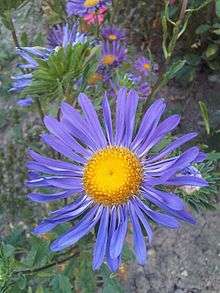Callistephus
Callistephus /kæˈlɪstɪfəs/[3] is a monotypic genus of flowering plants in the aster family, Asteraceae, containing the single species Callistephus chinensis. Its common names include China aster and annual aster.[4][5] It is native to China and Korea.[4][6] and it is cultivated worldwide as an ornamental plant in cottage gardens and as a cut flower.[2][7]
| Callistephus | |
|---|---|
 | |
| Callistephus chinensis | |
| Scientific classification | |
| Kingdom: | |
| (unranked): | |
| (unranked): | |
| (unranked): | |
| Order: | |
| Family: | |
| Tribe: | |
| Genus: | Callistephus |
| Species: | C. chinensis |
| Binomial name | |
| Callistephus chinensis | |
| Synonyms[2] | |
| |
Description
This is an annual or biennial herb with one erect, mostly unbranched stem growing 20 to 100 centimeters tall. The alternately arranged leaves vary in shape or size. The basal leaves usually fall away before flowering. Leaves around the middle of the stem are a few centimeters long and are borne on winged petioles. The blades have serrated edges. Leaves toward the top may have smooth edges. The large solitary flower head grows at the top of the stem and sometimes on branches. The head is lined with layers of phyllaries, those in the outer layer large and leaflike, measuring up to 3 centimeters long. The inner layer can be purple-tinged. The head contains one or two rings of ray florets, most often in shades of reddish purple.[8] The flowering period is from August to October in the northern hemisphere.[4]
Cultivation
This species has been grown and bred extensively in cultivation. Cultivars are available with flowers of many colors, varying heights, and single and double heads. In the wild, they are purple in color.[6] There are several cultivars with flowers of different colors. Cultivars with flowers of other colors were obtained in particular by hybridization. Cultivated varieties can have ray florets in most any color, including red, pink, blue, purple, and white. They are up to 3.5 centimeters long. There are many yellow disc florets in the center. The fruit is a rough-textured, glandular, purple-mottled cypsela that turns gray with age. It has a pappus composed of one outer layer of reddish scales and two inner layers of white bristles.[7][9]
It has been in culture in Europe since 1728 at the latest. In China, it has been cultivated for 2000 years.
Distribution
This plant is a naturalized species in some areas outside of its native range (Indochina, Europe, North America, Australia, New Zealand, etc.) and can be found on the edges of deciduous forests.[2] It grows at altitudes from 300 to 2700 above mean sea level. As ornamental plant it thrives on fresh, nutrient-rich, easy-humus rich soils in warm humid air conditioning.[10]
Pests and diseases
The plants are susceptible to fusarium wilt, a fungal disease. Some cultivars are more resistant to this than others. Pest insects can include leafhoppers, aphids, blister beetles, and the tarnished plant bug. The plant is also susceptible to mites.[5]
Gallery
- In pink
.jpg) In lilac
In lilac In yellow
In yellow.jpg) Red
Red.jpg) Purple flowers
Purple flowers Mix colours
Mix colours_02.jpg) In a garden
In a garden- Caterpillar feeding on white flower
 Natural habitat
Natural habitat Garden setting
Garden setting Round, fluffy flower
Round, fluffy flower.jpg) Aster de Chine (1833) by Pierre-Joseph Redouté
Aster de Chine (1833) by Pierre-Joseph Redouté.jpg) On a 1970 USSR postage stamp
On a 1970 USSR postage stamp
References
| Wikimedia Commons has media related to Callistephus. |
- Nesom, G. L. (1994). Subtribal classification of the Astereae (Asteraceae). Phytologia 76, 193–274. Cited in: Noyes, R. D. and L. H. Rieseberg (1999). ITS sequence data support a single origin for North American Astereae (Asteraceae) and reflect deep geographic divisions in Aster s. l. American Journal of Botany 86, 398–412.
- "Flann, C (ed) 2009+ Global Compositae Checklist". Archived from the original on 2014-11-11. Retrieved 2014-11-11.
- Sunset Western Garden Book, 1995:606–607
- "Callistephus". Germplasm Resources Information Network (GRIN). Agricultural Research Service (ARS), United States Department of Agriculture (USDA). Retrieved 10 January 2018.
- Gilman, E. F. and T. Howe. Callistephus chinensis. Fact Sheet FPS-94. University of Florida IFAS. 1999.
- Callistephus chinensis. Missouri Botanical Garden.
- Callistephus chinensis. Flora of China.
- Li, H., T. Liu, T. Huang, T. Koyama and CE DeVol. 1979. Vascular Plants. Volume 6: 665 pp. In Fl. Taiwan. Epoch Publishing Co., Ltd., Taipei.
- Jean Trudel , Gardens and scenery: summer flowers , Saint-Laurent (Quebec), Livre-Loisirs Ltée, 65 p. ISBN 2-89210-229-4
- David John Mabberley: Mabberley's Plant-Book. A portable dictionary of plants, their classification and uses . 3rd ed. Cambridge University Press 2008. Page 138. ISBN 978-0-521-82071-4